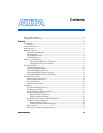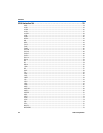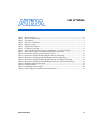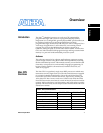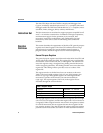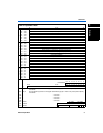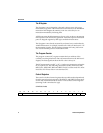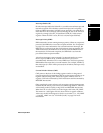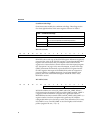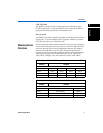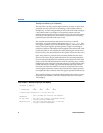
2 Altera Corporation
Overview
The Nios CPU ships with the GNUPro compiler and debugger from
Cygnus, an industry-standard open-source C/C++ compiler, linker and
debugger toolkit. The GNUPro toolkit includes a C/C++ compiler, macro-
assembler, linker, debugger, binary utilities, and libraries.
Instruction Set
The Nios instruction set is tailored to support programs compiled from C
and C++. It includes a standard set of arithmetic and logical operations,
and instruction support for bit operations, byte extraction, data
movement, control flow modification, and conditionally executed
instructions, which can be useful in eliminating short conditional
branches.
Register
Overview
This section describes the organization of the Nios CPU general-purpose
registers and control registers. The Nios CPU architecture has a large
general-purpose register file, several machine-control registers, a
program counter, and the K register used for instruction prefixing.
General-Purpose Registers
The general-purpose registers are 32 bits wide in the 32-bit Nios CPU and
16 bits wide in the 16-bit Nios CPU. The register file size is configurable
and contains a total of either 128, 256, or 512 registers. The software can
access the registers using a 32-register-long sliding window that moves
with a 16-register granularity. This sliding window can traverse the entire
register file. This sliding window provides access to a subset of the
register file.
The register window is divided into four even sections as shown in
Table 5. The lowest eight registers (%r0-%r7) are global registers, also
known as %g0-%g7. These global registers do not change with the
movement or position of the window, but remain accessible as
(%g0-%g7). The top 24 registers (%r8-%r31) in the register file are
accessible through the current window.
The top eight registers (%i0-%i7) are known as in registers, the next eight
(%L0-%L7) as local registers, and the other eight (%o0-%o7) are known as
out registers. When a register window moves down 16-registers (as it does
for a SAVE instruction), the out registers become the in registers of the
new window position. Also, the local and in registers of the last window
position become inaccessible. See Table 6 for more detailed information.
Table 5. Register Groups
In registers %r24-%r31 or %i0-%i7
Local registers %r16-%r23 or %L0-%L7
Out registers %r8-%r15 or %o0-%o7
Global registers %r0-%r7 or %g0-%g7




